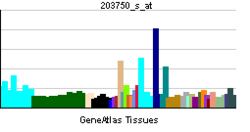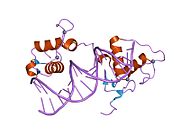Receptor retinoinske kiseline alfa
| Receptor retinoinske kiseline, alfa | |||||||||||
|---|---|---|---|---|---|---|---|---|---|---|---|
 PDB slika je bazirana na 1dkf. | |||||||||||
| Dostupne strukture | |||||||||||
| 1dkf, 1dsz, 1hra | |||||||||||
| Identifikatori | |||||||||||
| Simboli | RARA; NR1B1; RAR | ||||||||||
| Vanjski ID | OMIM: 180240 MGI: 97856 HomoloGene: 20262 GeneCards: RARA Gene | ||||||||||
| |||||||||||
| Pregled RNK izražavanja | |||||||||||
 | |||||||||||
 | |||||||||||
 | |||||||||||
| podaci | |||||||||||
| Ortolozi | |||||||||||
| Vrsta | Čovek | Miš | |||||||||
| Entrez | 5914 | 19401 | |||||||||
| Ensembl | ENSG00000131759 | ENSMUSG00000037992 | |||||||||
| UniProt | P10276 | Q3U3R3 | |||||||||
| RefSeq (mRNA) | NM_001033603 | NM_009024 | |||||||||
| RefSeq (protein) | NP_001028775 | NP_033050 | |||||||||
| Lokacija (UCSC) | Chr 17: 35.72 - 35.77 Mb | Chr 11: 98.75 - 98.79 Mb | |||||||||
| PubMed pretraga | [1] | [2] | |||||||||
Receptor retinoinske kiseline alfa (RAR-alfa), isto poznat kao NR1B1 (nuklearni receptor potfamilije 1, grupa B, član 1), je nuklearni receptor kodiran genom RARA.
Interakcije
Pokazano je za receptor retinoinske kiseline gama da može da formnira interakciju sa NCOA6,[1][2][3] CLOCK,[4] TADA3L,[5] Cink prst i BTB domen-sadržavajući protein 16,[6] Src,[7][8] Nuklearni receptor srodni 1 protein (NURR1),[9] Mali heterodimer partner (SHP),[10][11] NPAS2,[4] Cyclin D3,[12] Nuklearni receptor korepresor 1,[13][14] BAG1,[15] Nuklearni receptor korepresor 2,[16][17] NRIP1,[18][19][20] Protein promielocitna leukemije[21] i Retinoidni X receptor alfa.[22][23]
Vidi još
- Receptor retinoinske kiseline
- Akutna promijelocitna leukemija
Reference
- ^ Lee, S K; Jung S Y; et al. (2001). „Two distinct nuclear receptor-interaction domains and CREB-binding protein-dependent transactivation function of activating signal cointegrator-2”. Mol. Endocrinol. United States. 15 (2): 241—54. ISSN 0888-8809. PMID 11158331.
- ^ Lee, S K; Anzick S L; et al. (1999). „A nuclear factor, ASC-2, as a cancer-amplified transcriptional coactivator essential for ligand-dependent transactivation by nuclear receptors in vivo”. J. Biol. Chem. UNITED STATES. 274 (48): 34283—93. ISSN 0021-9258. PMID 10567404.
- ^ Ko, L; Cardona G R; Chin W W (2000). „Thyroid hormone receptor-binding protein, an LXXLL motif-containing protein, functions as a general coactivator”. Proc. Natl. Acad. Sci. U.S.A. UNITED STATES. 97 (11): 6212—7. ISSN 0027-8424. PMID 10823961.
- ^ а б McNamara, P; Seo S B; et al. (2001). „Regulation of CLOCK and MOP4 by nuclear hormone receptors in the vasculature: a humoral mechanism to reset a peripheral clock”. Cell. United States. 105 (7): 877—89. ISSN 0092-8674. PMID 11439184.
- ^ Zeng, Musheng; Kumar Ajay; et al. (2002). „Human papilloma virus 16 E6 oncoprotein inhibits retinoic X receptor-mediated transactivation by targeting human ADA3 coactivator”. J. Biol. Chem. United States. 277 (47): 45611—8. ISSN 0021-9258. PMID 12235159. doi:10.1074/jbc.M208447200.
- ^ Martin; Delmotte; et al. (2003). „PLZF is a negative regulator of retinoic acid receptor transcriptional activity”. Nucl. Recept. 1 (1): 6. PMID 14521715. doi:10.1186/1478-1336-1-6.
- ^ Kim, H J; Yi J Y; et al. (1999). „Activating signal cointegrator 1, a novel transcription coactivator of nuclear receptors, and its cytosolic localization under conditions of serum deprivation”. Mol. Cell. Biol. UNITED STATES. 19 (9): 6323—32. ISSN 0270-7306. PMID 10454579.
- ^ He, Bin; Wilson Elizabeth M (2003). „Electrostatic modulation in steroid receptor recruitment of LXXLL and FXXLF motifs”. Mol. Cell. Biol. United States. 23 (6): 2135—50. ISSN 0270-7306. PMID 12612084.
- ^ Perlmann, T; Jansson L (1995). „A novel pathway for vitamin A signaling mediated by RXR heterodimerization with NGFI-B and NURR1”. Genes Dev. UNITED STATES. 9 (7): 769—82. ISSN 0890-9369. PMID 7705655.
- ^ Seol, W; Choi H S; Moore D D (1996). „An orphan nuclear hormone receptor that lacks a DNA binding domain and heterodimerizes with other receptors”. Science. UNITED STATES. 272 (5266): 1336—9. ISSN 0036-8075. PMID 8650544.
- ^ Seol, W; Hanstein B; et al. (1998). „Inhibition of estrogen receptor action by the orphan receptor SHP (short heterodimer partner)”. Mol. Endocrinol. UNITED STATES. 12 (10): 1551—7. ISSN 0888-8809. PMID 9773978.
- ^ Despouy, Gilles; Bastie Jean-Nöel; et al. (2003). „Cyclin D3 is a cofactor of retinoic acid receptors, modulating their activity in the presence of cellular retinoic acid-binding protein II”. J. Biol. Chem. United States. 278 (8): 6355—62. ISSN 0021-9258. PMID 12482873. doi:10.1074/jbc.M210697200.
- ^ Dowell, P; Ishmael J E; et al. (1999). „Identification of nuclear receptor corepressor as a peroxisome proliferator-activated receptor alpha interacting protein”. J. Biol. Chem. UNITED STATES. 274 (22): 15901—7. ISSN 0021-9258. PMID 10336495.
- ^ Guidez, F; Ivins S; et al. (1998). „Reduced retinoic acid-sensitivities of nuclear receptor corepressor binding to PML- and PLZF-RARalpha underlie molecular pathogenesis and treatment of acute promyelocytic leukemia”. Blood. UNITED STATES. 91 (8): 2634—42. ISSN 0006-4971. PMID 9531570.
- ^ Liu, R; Takayama S; et al. (1998). „Interaction of BAG-1 with retinoic acid receptor and its inhibition of retinoic acid-induced apoptosis in cancer cells”. J. Biol. Chem. UNITED STATES. 273 (27): 16985—92. ISSN 0021-9258. PMID 9642262.
- ^ Dong, Shuo; Tweardy David J (2002). „Interactions of STAT5b-RARalpha, a novel acute promyelocytic leukemia fusion protein, with retinoic acid receptor and STAT3 signaling pathways”. Blood. United States. 99 (8): 2637—46. ISSN 0006-4971. PMID 11929748.
- ^ Hong, S H; David G; et al. (1997). „SMRT corepressor interacts with PLZF and with the PML-retinoic acid receptor alpha (RARalpha) and PLZF-RARalpha oncoproteins associated with acute promyelocytic leukemia”. Proc. Natl. Acad. Sci. U.S.A. UNITED STATES. 94 (17): 9028—33. ISSN 0027-8424. PMID 9256429.
- ^ Hu, Xinli; Chen Yixin; et al. (2004). „Suppressive effect of receptor-interacting protein 140 on coregulator binding to retinoic acid receptor complexes, histone-modifying enzyme activity, and gene activation”. J. Biol. Chem. United States. 279 (1): 319—25. ISSN 0021-9258. PMID 14581481. doi:10.1074/jbc.M307621200.
- ^ Farooqui, Mariya; Franco Peter J; et al. (2003). „Effects of retinoid ligands on RIP140: molecular interaction with retinoid receptors and biological activity”. Biochemistry. United States. 42 (4): 971—9. ISSN 0006-2960. PMID 12549917. doi:10.1021/bi020497k.
- ^ L'Horset, F; Dauvois S; et al. (1996). „RIP-140 interacts with multiple nuclear receptors by means of two distinct sites”. Mol. Cell. Biol. UNITED STATES. 16 (11): 6029—36. ISSN 0270-7306. PMID 8887632.
- ^ Zhong, S; Delva L; et al. (1999). „A RA-dependent, tumour-growth suppressive transcription complex is the target of the PML-RARalpha and T18 oncoproteins”. Nat. Genet. UNITED STATES. 23 (3): 287—95. ISSN 1061-4036. PMID 10610177. doi:10.1038/15463.
- ^ Benkoussa, Madjid; Brand Céline; et al. (2002). „Retinoic acid receptors inhibit AP1 activation by regulating extracellular signal-regulated kinase and CBP recruitment to an AP1-responsive promoter”. Mol. Cell. Biol. United States. 22 (13): 4522—34. ISSN 0270-7306. PMID 12052862.
- ^ Bugge, T H; Pohl J; et al. (1992). „RXR alpha, a promiscuous partner of retinoic acid and thyroid hormone receptors”. EMBO J. ENGLAND. 11 (4): 1409—18. ISSN 0261-4189. PMID 1314167.











